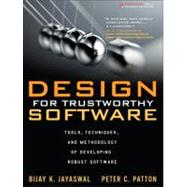
What is included with this book?
Bijay K. Jayaswal holds a B.Eng. (Hons.) degree in electrical engineering from the Birla Institute of Technology and Science, Pilani, India, and an MBA and a master’s degree in electrical engineering from Aston University in England. He is the CEO of Agilenty Consulting Group, LLC. He has held senior executive positions and has consulted in quality and strategy for the last 25 years. His consulting and research interests include value engineering, process improvement, and product development. He has taught engineering and management at the University of Mauritius and California State University, Chico and has directed MBA and Advanced Management programs. He has helped introduce corporate-wide initiatives in reengineering, Six Sigma, and Design for Six Sigma and has worked with senior executive teams to implement such initiatives. He can be contacted at bijay.jayaswal@agilenty.com.
Dr. Peter C. Patton is Professor of Quantitative Methods and Computer Science at the University of St. Thomas, St. Paul, Minnesota. He also is Chairman of Agilenty Consulting Group. He has taught at the Universities of Minnesota, Paris, and Stuttgart and has held the position of Chief Information Officer at the University of Pennsylvania. He has engineering and mathematics degrees from Harvard, Kansas, and Stuttgart. He was Chief Technologist at Lawson Software from 1996 to 2002. He was Lawson’s representative on the Technical Advisory Committee of IBM’s SanFrancisco™ Java Framework project. He has been involved in computer hardware and software development since 1955. He can be contacted at peter.patton@agilenty.com.
Foreword xxv
Preface xxvii
Acknowledgments xxxiii
About the Authors xxxv
PART I C ONTEMPORARY S OFTWARE D EVELOPMENT P ROCESS , T HEIR S HORTCOMINGS , AND THE C HALLENGE OF T RUSTWORTHY S OFTWARE
CHAPTER 1 Software Development Methodology Today 3
CHAPTER 2 The Challenge of Trustworthy Software: Robust Design in Software Context 35
CHAPTER 3 Software Quality Metrics 69
CHAPTER 4 Financial Perspectives on Trustworthy Software 95
CHAPTER 5 Organizational Infrastructure and Leadership for DFTS 139
PART II T OOLS AND T ECHNIQUES OF D ESIGN FOR T RUSTWORTHY S OFTWARE
CHAPTER 6 The Seven Basic (B7) Tools of Quality 193
CHAPTER 7 The 7 MP Tools: Analyzing and Interpreting Qualitative and Verbal Data 227
CHAPTER 8 The Analytic Hierarchy Process 253
CHAPTER 9 Complexity, Mistakes, and Poka Yoke in Software Development Processes 303
CHAPTER 10 5S for Intelligent Housekeeping in Software Development 329
CHAPTER 11 Understanding Customer Needs: Software QFD and the Voice of the Customer 345
CHAPTER 12 Creativity and Innovation in the Software Design Process: TRIZ and Pugh Concept Selection Methodology 405
CHAPTER 13 Risk Assessment and Failure Modes and Effects Analysis in Software 431
CHAPTER 14 Object and Component Technologies and Other Development Tools 449
PART III D ESIGNING FOR T RUSTWORTHY S OFTWARE
CHAPTER 15 Quality Measures and Statistical Methods for Trustworthy Software 479
CHAPTER 16 Robust Software in Context 499
CHAPTER 17 Taguchi Methods and Optimization for Robust Software 511
CHAPTER 18 Verification, Validation, Testing, and Evaluation for Trustworthiness 533
CHAPTER 19 Integration, Extension, and Maintenance for Trustworthiness 553
PART IV P UTTING I T A LL T OGETHER : D EPLOYMENT OF A DFTS P ROGRAM
CHAPTER 20 Organizational Preparedness for DFTS 567
CHAPTER 21 Launching a DFTS Initiative 587
PART V S IX C ASE S TUDIES
CHAPTER 22 Cost of Software Quality (CoSQ) at Raytheon’s Electronic Systems (RES) Group 633
CHAPTER 23 Information Technology Portfolio Alignment 643
CHAPTER 24 Defining Customer Needs for Brand-New Products: QFD for Unprecedented Software 665
CHAPTER 25 Jurassic QFD: Integrating Service and Product Quality Function Deployment 685
CHAPTER 26 Project QFD: Managing Software Development Projects Better with Blitz QFD 707
CHAPTER 27 QFD 2000: Integrating QFD and Other Quality Methods to Improve the New-Product Development Process 729
Glossary of Technical Terms 745
Name Index 753
Index 759
The New copy of this book will include any supplemental materials advertised. Please check the title of the book to determine if it should include any access cards, study guides, lab manuals, CDs, etc.
The Used, Rental and eBook copies of this book are not guaranteed to include any supplemental materials. Typically, only the book itself is included. This is true even if the title states it includes any access cards, study guides, lab manuals, CDs, etc.